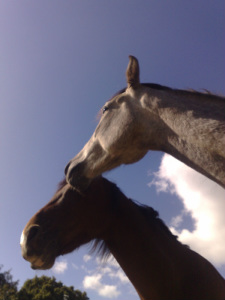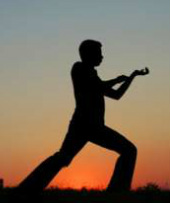T'ai Chi and Qi Gong and how they relate to riding and handling horses |
|
|
T'ai Chi and horsemanship
The connection between martial arts and horsemanship has been a wonderful revelation to me. Through studying and practicing T'ai Chi, I have realised how much our riding can improve by developing a better understanding of ourselves and by using our bodies more efficiently and thoughtfully. The warm-ups (joint mobility) are an excellent way not only to free up our day to day stiffnesses, they also help us to feel where we hold our tension, where we tend to lose stability through being too floppy so that we can correct ourselves. The basic T'ai Chi movements have given me huge insight into how to create poise instead of posture (which is often too rigid), how each part of body needs to connect with the rest in any movement, ‘one part moves all parts,’ there is more power when you are loose than when you are rigid, and that we all move differently. |
There are four levels in the style I am practising,
Movement – the mechanics of a move. You break down when and where and how each limb moves and in what order. So in martial arts this is a throw/kick, etc., and of course, in riding this is like the mechanics of leading, a turn etc. This is practised until it becomes a muscle memory.
Breathing – adds mindfulness and connection. For T'ai Chi you learn to breathe in and out as you rise and sink. It adds more power to a move and helps create a meditative state - enhancing focus. With horses it allows us to control emotion, enter into the moment, prepare for a change (a half-halt) and connect with the rhythm of the horse.
Martial – this is the fighting aspect. So for T'ai Chi this teaches me where I am being attacked from and where I am aiming to defend myself and reciprocate with a move. With horses, there is no fighting, it helps us to deflect rather than rise to a fight, which some horses expect with humans. By understanding the overall movement expected of the horse, how they should shape and where we are heading, we improve focus and intention.
Fajing – where all three come together. In T'ai Chi, this is where you become a lean, mean fighting machine. You can respond to any movement at lightning speed because body, mind and spirit are working as one. With horses, this is the moment where you are at one with your horse, you float in perfect harmony and balance and your horse responds to your thoughts and you are truly in the moment.
The first five essences of T'ai Chi fit beautifully into horsemanship.
Centre Left Right Forward Backward
Every one movement of human and horse has a combination of these. If you start to examine what elements are in each movement and in what part of the horse body, this helps us replicate it in our own bodies and use as effective cues.
Centre (up and down) is the hardest and most important essence. Centring our body, attitudes, emotions and thoughts is essential for good horsemanship.
T'ai Chi also works on the extremes to find centre. As an example, to feel whether you are tight in your wrists when you are riding, rather than trying to guess, go really stiff and rigid in your wrists, release, then let them give them a good shake, then place your hands back in a riding position: do they feel different? Does you horse respond to the difference?
Whether we like it or not, understanding ourselves mentally, emotionally and physically has a huge impact on our relationship and training with our horses.
- movement
- breathing
- martial
- fajing
Movement – the mechanics of a move. You break down when and where and how each limb moves and in what order. So in martial arts this is a throw/kick, etc., and of course, in riding this is like the mechanics of leading, a turn etc. This is practised until it becomes a muscle memory.
Breathing – adds mindfulness and connection. For T'ai Chi you learn to breathe in and out as you rise and sink. It adds more power to a move and helps create a meditative state - enhancing focus. With horses it allows us to control emotion, enter into the moment, prepare for a change (a half-halt) and connect with the rhythm of the horse.
Martial – this is the fighting aspect. So for T'ai Chi this teaches me where I am being attacked from and where I am aiming to defend myself and reciprocate with a move. With horses, there is no fighting, it helps us to deflect rather than rise to a fight, which some horses expect with humans. By understanding the overall movement expected of the horse, how they should shape and where we are heading, we improve focus and intention.
Fajing – where all three come together. In T'ai Chi, this is where you become a lean, mean fighting machine. You can respond to any movement at lightning speed because body, mind and spirit are working as one. With horses, this is the moment where you are at one with your horse, you float in perfect harmony and balance and your horse responds to your thoughts and you are truly in the moment.
The first five essences of T'ai Chi fit beautifully into horsemanship.
Centre Left Right Forward Backward
Every one movement of human and horse has a combination of these. If you start to examine what elements are in each movement and in what part of the horse body, this helps us replicate it in our own bodies and use as effective cues.
Centre (up and down) is the hardest and most important essence. Centring our body, attitudes, emotions and thoughts is essential for good horsemanship.
T'ai Chi also works on the extremes to find centre. As an example, to feel whether you are tight in your wrists when you are riding, rather than trying to guess, go really stiff and rigid in your wrists, release, then let them give them a good shake, then place your hands back in a riding position: do they feel different? Does you horse respond to the difference?
Whether we like it or not, understanding ourselves mentally, emotionally and physically has a huge impact on our relationship and training with our horses.
Qi Gong

Horses join me doing Qi Gong
Qi Gong is the healing side of T'ai Chi; an ancient practice of moving meditation. It aligns breath, physical movement and present-awareness (mindfulness), with the aim of enhancing well-being by enabling the free flow of Qi through the body. Just like other forms of meditation and self-development methods, Qi Gong has many health benefits including
Qi Gong literally means the ‘skill’ of Qi. Qi is a difficult word to translate as we simply don't have a word for it in English. Some translate Qi into breathing as many styles control their Qi with breath, you may also hear it described as life force or energy. I have found that focusing on your breathing and being able to change it has a huge impact on how your energy works to control the movement of a horse. The more skilled I am getting, the less I think about it and become at one with the movement and rhythm of a horse. I've also found that if I practise Qi Gong near your horses they will come and be with you, something we forget to do in this busy world, just be.
Breathing and understanding the energy dynamics whilst working a horse improves intent, which means thoughts become cues. As my body responds to the thought and my horse responds within the moment – it truly becomes a dance!
All of these can be broken down into simple exercises for you to take home and play with!
- activating the body’s self-healing capacity (helps the immune system)
- an effective form of stress relief and releases stress held in the body (means you don't take it into your riding)
- improves concentration (learn more efficiently)
- strengthens muscles and promotes muscular endurance (you are more likely to stay on!)
- encourages poise and flexibility (horses respond by mirroring with their own posture)
- improves cardiovascular functioning
- helps you regulate your emotional response to any situation (horses will look for your response)
- enables you to be more in control of your thoughts (so you can replace negative thoughts with positive ones)
- become more self-aware, which gives you the ability to release self-limiting beliefs (means you get more out of your time with your horse)
- consciously move energy through your body (particularly obvious in liberty)
- maintain a calmer, happier frame of mind, regardless of outside influences (this is my favourite round the horses and the horse love it!)
Qi Gong literally means the ‘skill’ of Qi. Qi is a difficult word to translate as we simply don't have a word for it in English. Some translate Qi into breathing as many styles control their Qi with breath, you may also hear it described as life force or energy. I have found that focusing on your breathing and being able to change it has a huge impact on how your energy works to control the movement of a horse. The more skilled I am getting, the less I think about it and become at one with the movement and rhythm of a horse. I've also found that if I practise Qi Gong near your horses they will come and be with you, something we forget to do in this busy world, just be.
Breathing and understanding the energy dynamics whilst working a horse improves intent, which means thoughts become cues. As my body responds to the thought and my horse responds within the moment – it truly becomes a dance!
All of these can be broken down into simple exercises for you to take home and play with!


